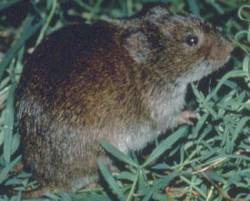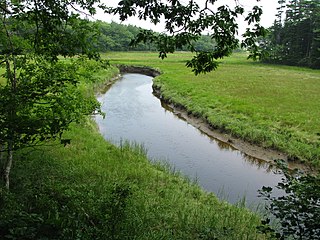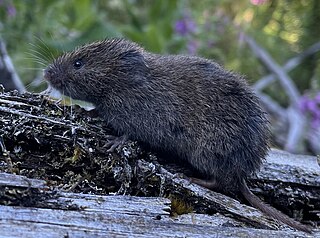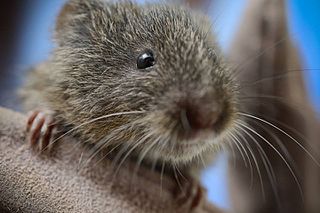
The eastern meadow vole, sometimes called the field mouse or meadow mouse, is a North American vole found in eastern Canada and the United States. Its range extends farther south along the Atlantic coast.

Microtus is a genus of voles found in North America, Europe and northern Asia. The genus name refers to the small ears of these animals. They are stout rodents with short ears, legs and tails. They eat green vegetation such as grasses and sedges in summer, and grains, seeds, root and bark at other times. The genus is also called "meadow voles".

The North American water vole or just water vole is the largest North American vole. It is found in the northwestern United States and southern parts of western Canada. This animal has been historically considered a member of genus Arvicola, but molecular evidence demonstrates that it is more closely related to North American Microtus species. Water voles are on the USDA Forest Service Region 2 sensitive species list because they maintain very small populations and there is high concern that their required habitat may be declining.

The long-tailed vole, in some areas known as the San Bernardino long-tailed vole, is a small vole found in western North America. They have short ears and a long tail. Their fur is gray brown with light gray underparts. They are around 18 cm (7.1 in) long with an 8 cm (3.1 in) tail and weigh about 50 g (1.8 oz).

The prairie vole is a small vole found in central North America.

Waccasassa Bay Preserve State Park is a 30,784-acre (124.58 km2) salt marsh that stretches from Cedar Key to Yankee Town, and is only accessible by boat. It includes the part of Gulf Hammock wetlands area that is closest to the Gulf.

The Rachel Carson National Wildlife Refuge is a 9,125-acre (37 km2) National Wildlife Refuge made up of several parcels of land along 50 miles (80 km) of Maine's southern coast. Created in 1966, it is named for environmentalist and author Rachel Carson, whose book Silent Spring raised public awareness of the effects of DDT on migratory songbirds, and of other environmental issues.

The beach vole or Muskeget vole is a rodent in the family Cricetidae. This close relative of the eastern meadow vole is endemic to the 0.87 km2 Muskeget Island, Massachusetts. Due to its relatively short period of reproductive isolation, there is debate over the beach vole's designation as a subspecies of M. pennsylvanicus.

The creeping vole, sometimes known as the Oregon meadow mouse, is a small rodent in the family Cricetidae. Ranging across the Pacific Northwest of North America, it is found in forests, grasslands, woodlands, and chaparral environments. The small-tailed, furry, brownish-gray mammal was first described in the scientific literature in 1839, from a specimen collected near the mouth of the Columbia River. The smallest vole in its range, it weighs around 19 g. At birth, they weigh 1.6 g, are naked, pink, unable to open their eyes, and the ear flaps completely cover the ear openings. Although not always common throughout their range, there are no major concerns for their survival as a species.

Townsend's vole is a species of rodent in the family Cricetidae, the sister species of M. canicaudus. It is found in temperate grasslands of British Columbia in Canada and in the states of Washington and Oregon in the United States.

Mynomes is a North American subgenus of voles in the genus Microtus. Species in this subgenus are:
Listrophorus is a genus of parasitic mites in the family Listrophoridae. North American species with their hosts include:

The Amargosa vole is one of 17 subspecies of the California vole. The most closely related subspecies is M. californicus vallicola.

The western meadow vole is a species of North American vole found in midwestern and western Canada and the United States, and formerly in Mexico. It was formerly considered conspecific with the eastern meadow vole, but genetic studies indicate that it is a distinct species.

Microtini is a tribe of voles in the subfamily Arvicolinae.
















